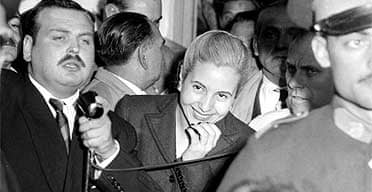Eva Peron prompted adulation and loathing in equal measure during her time as one of the most powerful women in Latin America. Yet a more 'intimate, sweet and spontaneous' side of Evita is said to have been revealed for the first time with the discovery and restoration of more than 600 images documenting her six years as Argentina's first lady.
The images, which were hidden for more than 40 years, have been put on show in Argentina by historian Maria Teresa Mazzorotolo, the daughter of Peron's personal photographer.
'All these decades could not erase the images that captured the soul of this woman,' Mazzorotolo told The Observer. 'The pictures show a woman in constant activity, a robust, lively young girl who is not posing for the camera but expresses spontaneous gestures of laughter and sadness as if there was no one watching.'
Born out of wedlock in rural Argentina in 1919, 'Little Eva' escaped to Buenos Aires to become a radio presenter and an actress. She married President Juan Domingo Peron and remained first lady from 1946 until her death from cancer in 1952.
Photographer Alfredo Mazzorotolo, commissioned by his newspaper, Democracia, shadowed Evita and captured some of Peron's most personal moments. After a military uprising ended Peron's second presidency, keeping anything to do with the old regime became an offence. Mazzorotolo put his negatives in a casket and buried them. Some 20 years later, when the dictatorship ended, he dug them up, but it was another 20 years before he told his daughter about them.
In September 1947, Eva Peron forced congress to pass a law allowing women to vote. Mazzorotolo has chosen this anniversary to show her father's work. 'Love her or hate her, Peron was responsible for a more active role of women in the country's political life,' she says. Critics have praised the exhibition at Argentina's Institute for Cinema and Audiovisual Arts for showing Evita's 'softer side'.
Mazzorotolo says: 'The pictures highlight the row between supporters and enemies of Peron during a period in which society was so fragmented that a man had to hide certain images to prevent people from destroying our history.'
